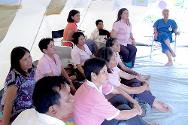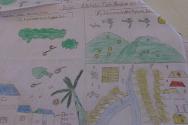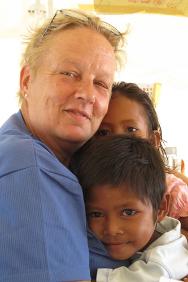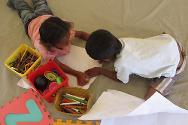Philippines: Young typhoon survivors brush off their woes with colours
23-04-2013 Feature
The devastation wrought by typhoon Bopha in the Southern Philippines has changed the lives of many, especially children traumatized by the experience. ICRC communication delegate Marie-Claire Feghali looks at how psychosocial support has made a difference by helping vulnerable children in one of the worst-hit areas.
As Kati Partanen looked out from the white tent in the direction of a tarpaulin, under which some of “her children” live, Malou Rodriguez prepared the place for their new drawing session. Here, at the Red Cross Basic Health Care Unit in Baganga, Davao Oriental province, the little victims of typhoon Bopha come for a chat, hugs and some colouring.
In the ICRC’s response to the typhoon, psychosocial support was, for the first time, included as part of its emergency healthcare deployment. This specialized support was meant to address trauma experienced by survivors of the typhoon that hit Eastern Mindanao in early December 2012.
Kati and Malou, both registered nurses, are proud to be part of the response in Baganga, one of the most devastated areas that the ICRC and the Philippine Red Cross continue to assist. They live amidst hundreds of drawings that tell the experiences of children during and after the typhoon.
“We all have feelings and thoughts to express,” said Malou, who was one of the original members of the Red Cross health team to provide psychosocial support. “Children, however, cannot always talk,” she added. “Instead, they draw.”
Support in more ways than one
Between January and March 2013, the psychosocial support tent received more than 900 patients from among some 7,000 who visited the Basic Health Care Unit set up by the ICRC in collaboration with the Philippine Red Cross. Aside from psychosocial support, the Unit offered free consultations and outpatient treatment, vaccinations, as well as maternal and child care services.
This emergency facility, which was also supported by the Japanese Red Cross Society, aimed at meeting basic healthcare needs after existing local health units were severely damaged by the typhoon. Medical professionals from the national Red Cross societies of Japan, Canada, Finland, Germany, Norway and the Philippines composed the Basic Health Care Unit's staff, supported by highly qualified Philippine colleagues.
Drawing their feelings
As part of a ‘My experience in Pablo’ project run in two schools in Baganga, children were encouraged to draw their feelings. “Here,” explained Kati, “11-year-old Roylan Echonar drew black clouds, fallen coconut trees and destroyed houses, reflecting what his little mind registered of the event. Interestingly enough, he added helicopters and a Red Cross tent where he wrote ‘relief’.”
Another drawing showed people in line for a distribution of assistance, while a third showed only a house with bread. Intrigued, Malou asked the boy, “Is this your house? Why did you draw bread?” He was simply hungry, she thought. After a meal and a few hugs, he opened up to her. It turned out that his family of six was sharing only one can of sardines per day because his mother was saving the relief “for when another typhoon comes.”
Kati, who the children call ‘Lola’ (‘grandmother’ in the Filipino language), explained, “People have been deeply traumatized by the typhoon. Now every time they experience heavy rains, they are afraid their roofs will collapse, their trees will be uprooted and their livelihoods lost again.”
“Our aim was to bring the community to the recovery phase, which we managed to do by training 120 school principals and teachers in cognitive behavioural therapy,” added Kati. “Now, they apply everything we taught them to their pupils, who send us their drawings and prayers in gratitude.”
But is that enough in a place where people still struggle to get back to normality? Smiling, ‘Lola’ Kati said, “I know I cannot save all the children of the world, but if I change the life of one or two for the better, I would have accomplished something.”




